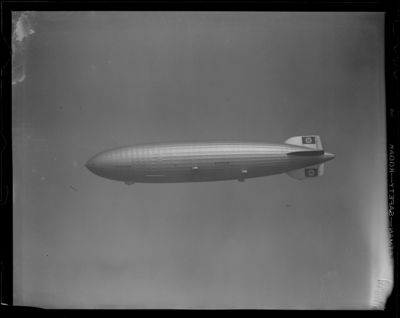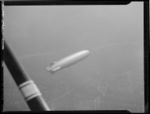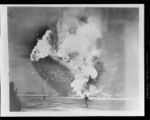Hindenburg disaster
The Hindenburg Disaster was an infamous airship catastrophe that occurred on May 6th, 1937. [1] The Hindenburg, one of the largest airships in the world, was the symbol of airships around the world. It was on this airship that the validity of travel by zeppelin rested. Developed by Nazi Germany, the Hindenburg, named after Germany's president, made a very useful tool in propaganda as well. The destruction of this massive ship marked the end of travel by airship, a huge blow to the Nazis, heavily damaging their credibility.
History
The Hindenburg, or LZ-129, was created by Luftschiffbau Zeppelin, headed by Hugo Eckener, and based in Germany. Construction of the zeppelin began in 1931, but the project had to be put on hold once the Depression began to put its squeeze on the project. However, once the Nazi Party came into power under Hitler, they decided to finance the project for propaganda purposes. The Nazis also split the company in two, removing Luftschiffbau Zeppelin's ability to control airship operations, as he was not viewed as loyal enough to the regime to be completely trusted with the project.
The Hindenburg was completed on March 4, 1936. However, in lieu of flight trials, Nazi officials instead had the ship immediately undergo a three day flight. Even when weather reports predicted especially breezy conditions, no changes were made to the plan. Predictably, the airship hadn't even begun its journey when the ground crew lost control of the ship and damaged its bottom wing. However, after the wing was fixed, the Nazis made good use out of the Hindenburg, including a 74 hour flight promoting the re-militarization the Rhineland. Yet even after this incident further problems occurred. endurance trials were never implemented, and the Hindenburg continued to suffer from mechanical errors which could have easily been caught were the Hindenburg ever vetted for problems.[2] Within a year, the Hindenburg had visited every major city in Germany. [3]
In 1936 the Hindenburg began its maiden voyage across the Atlantic ocean, arriving in the United States in just 2.5 days, about half the time of an ocean liner. However, this luxury airship was not for the poor. Compared to the 86 dollars needed for a third class spot on a liner, the 450 dollars required to ride the Hindenburg illustrates that it was used more for a luxury voyage than practicality. A symbol of both status and technological superiority, passengers of the Hindenburg were limited to the upper class. The Hindenburg had 34 successful flights across the Atlantic before its last flight on in October 1936. [2]
Inside of the Hindenburg

This airship was the status of luxury for its time, unparalleled by similar aircraft in terms of its amenities. The zeppelin consisted of two decks, A and B: deck A had two lounges with windows that along with passenger cabins, and deck B had the kitchen, crews' mess, and a smoke room. The smoke room on the Hindenburg was hailed as a feat of engineering for its time, as it required an air-lock to keep any hydrogen gas from leaking into it and bursting into flame. [3]
The Last Flight
The Hindenburg left the air on May 3, 1937 from Frankfurt, Germany. From there it made its way across the Netherlands and past Southern England, and entered the Atlantic around 2:00 AM on May 4th. The blimp was delayed by headwinds, and the arrival time in Lakehurst, New Jersey, was moved from 6:00 AM to 6:00 PM. The ship actually arrived around 4:15 PM, but once again the blimp could not land due to poor weather. [1] Conditions became favorable around 6:00 PM, but the captain, Max Pruss, waited another hour just to be certain. He began to land the ship around 7:00 pm. At 7:25 PM a small flame was observed on the tail fin of the blimp. Within seconds, the entire back section of the ship was on fire. After about thirty-four seconds, the entire airship was on fire. People began to jump out of the ship, many dying in the attempt. Miraculously though, only about one-third of the people on board died, with 62 out of the original 97 men and women aboard the Hindenburg living through this horrific experience. [4]
Cause of Explosion
Though many hypotheses have been considered regarding the Hindenburg Disaster, researchers at San Antonio's South West Research Institute have finally reached a consensus on the cause of the explosion. [5] Seventy-six years later, experts have concluded that static electricity caused the Hindenburg to burst into flames. The team, led by Jem Stansfield, an aeronautical engineer, methodically destroyed 78 foot long scale models of the Hindenburg, ruling out every possibility from terrorists to flammable paint. The team also interviewed eyewitnesses of the explosion, including people who had never publicly revealed their observations before. After piecing together these eyewitness accounts and based on there observations, these experts revealed that an electric storm caused the ship to become charged with static electricity, and a single spark was all it took to ignite the ship.
The Hindenburg was covered in cotton fabric, but was swabbed with highly inflammable cellulose acetate. However, the silver sheen of the ship, created by using aluminum powder, was very flammable. A single spark would cause this unusual source of color to easily burst into flame. [6]It is important to note that hydrogen was not the cause of the Hindenburg Disaster, but rather the aluminum powder, now a common ingredient in rocket fuel. [6] The Aluminum bursts into flame as it is oxidized, (2Al + Fe2O3 ==> Al2O3 + 2Fe) releasing massive amounts of energy. Hydrogen could not be the culprit, as the Hindenburg burned downward and in great color, while hydrogen burns upward and with a colorless flame. [7]
The End of Airships
Despite previous airship disasters, the speed and novelty of airships kept them in favor with the public. However, the Hindenburg was the first crash to be captured on film. Suddenly millions of people were privy to the dangers of airship travel, and weren't so eager to fly in one anymore. Also, by 1936 the B-314, an airplane, had been developed; it was able to cross the Atlantic in the exact same amount of time as the Hindenburg. Though air travel across the Atlantic by airplane would not occur until 1939, alternatives to the zeppelin were already developed. [4]
Video
Herb Morrison comments live on the destruction of the Hindenburg.
References
- ↑ 1.0 1.1 The Hindenburg Disaster Airships: The Hindenburg and other Zeppelins. Web. accessed at 27 May 2013. Author Unknown.
- ↑ 2.0 2.1 LZ-129 Hindenburg: A Detailed History Airships: The Hindenburg and other Zeppelins. Web. accessed at 27 May 2013. Author Unknown.
- ↑ 3.0 3.1 Rosenberg, Jennifer The Hindenburg A Giant and Luxurious Airship 20th Century History. Web. accessed at 27 May 2013.
- ↑ 4.0 4.1 Rosenberg, Jennifer [http://history1900s.about.com/cs/disasters/a/hindenburgcrash.htm Hindenburg Disaster The tragedy that ended lighter-than-air passenger travel in rigid dirigibles.] 20th Century History. Web. accessed at 27 May 2013.
- ↑ Poladian, Charles [http://www.ibtimes.com/what-caused-hindenburg-explode-scientists-believe-they-solved-mystery-1110898 What Caused The Hindenburg To Explode? Scientists Believe They Solved The Mystery] International Business Times. Web. accessed at 27 May 2013.
- ↑ 6.0 6.1 Kruszelnicki, Karl S. Hindenburg & Hydrogen ABC Science. Web. accessed at 27 May 2013.
- ↑ Brown, David. Hydrogen Didn’t Cause Hindenburg Fire, UCLA Engineer, Former NASA Researcher Find UCLA NEWS. Web. accessed at 27 May 2013.
| ||||||||||||||




